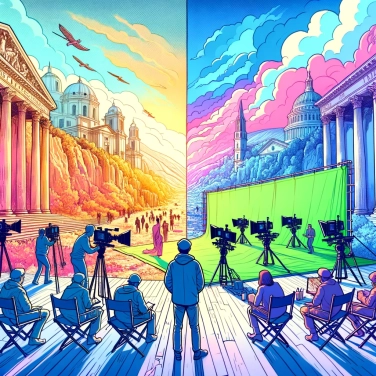Directors sometimes choose real locations because it can bring an aspect of authenticity and realism to their film, creating a better immersion for the viewers. Furthermore, shooting on location can help reduce production costs by avoiding the need for complex special effects in post-production.

Using real sets allows directors to offer audiences a concrete and authentic aesthetic, moving away from the often overly perfect images created in post-production. Natural materials, lighting, and textures spontaneously provide a credible and tangible visual effect that the human eye perceives as familiar. With a real set, shadows, reflections, and subtle little details appear naturally, giving the audience a more immersive experience. In contrast, purely digital sets can sometimes seem artificial, especially when their design lacks finesse or budget. When Christopher Nolan chooses to use real streets or when Peter Jackson builds entire villages for The Lord of the Rings, they instantly achieve that realistic and vibrant feeling that immediately immerses viewers in their world.
Filming in a real setting allows actors to truly feel their environment. They can directly touch, see, and interact with the objects around them, which enhances their acting performance. For example, being in a real rainforest or on a windy beach naturally stimulates their emotions and sensations. It's often more convincing than imagining things against a blank green screen. This authenticity helps viewers to better believe in the story being told, as the actors' reactions appear spontaneous and credible.
Filming in real locations creates an atmosphere that digital effects do not always manage to match. When a scene is shot in a real forest, a real castle, or a bustling street, the audience instinctively feels that it is authentic. This authenticity adds depth to the images and sounds, like the natural resonance of voices in a church or the dust swirling in an old attic. These kinds of details, sometimes minuscule, help immerse the viewer in the film's world in a way that is much more credible than digital sets, whose artifice can be unconsciously detected. This is one of the reasons why directors of thrillers or horror films love to use real locations: they know that the anxiety often relies on the sense of reality that the viewer experiences.
Building a real set directly requires a significant initial budget, but often allows for avoiding unexpected costs and frequent overruns associated with digital special effects. Directors sometimes favor tangible sets to control timelines and have a clear idea of the final result from the shoot, without having to wait for the end of an expensive post-production phase. In some complex cases, virtually recreating a detailed, credible, and lively set would have required entire teams of visual specialists working on computers for weeks on end. In contrast, physically building this set can prove to be faster, cheaper, and allow for immediate control over details and practical adjustments. This approach also limits unexpected technical risks, such as issues with digital integration, software troubles, or costly visual incompatibilities that need to be resolved later.
In Interstellar, Christopher Nolan chose to build full-scale space cockpits to enhance realism and help actors better immerse themselves. Well, piloting in a real space setting makes all the difference! The same goes for Peter Jackson in The Lord of the Rings: instead of digitally altering all the landscapes, he traveled across New Zealand in search of breathtaking natural locations. It gives the impression of exploring a truly credible universe. And we can't forget Mad Max: Fury Road, where George Miller opted for real stunts and vehicles specially built for the shoot, rather than an overdose of digital effects. The result? A raw energy that grabs the eye from the very first second.
Using real sets often significantly reduces post-production timelines, as it limits the need for sometimes lengthy and costly digital effects processing.
On the set of 'The Lord of the Rings', Peter Jackson built a life-sized version of the Hobbit houses in Matamata, New Zealand, which has since become a popular tourist attraction, demonstrating how real sets can continue to thrive long after the end of a film production.
Some directors choose natural settings to directly harness the authentic climatic and lighting conditions, as these atmospheres are difficult to replicate realistically through digital means.
For the film 'Inception' (2010), Christopher Nolan chose to build a real rotating corridor rather than relying on digital special effects, in order to elicit authentic reactions from the actors to the changes in gravity.
Sure! Here's the translation: "Yes, shooting in real locations requires careful planning and complex logistics. There are specific challenges such as legal permits, weather and geographical constraints, safety conditions, and costs related to the travel of the crew and equipment."
The special effects created in post-production offer exceptional flexibility for creating scenes that are impossible or too costly to produce in reality. They also allow for precise control of the final visual result, easy adaptation of effects after filming, and the creation of innovative or spectacular visual effects that are simply not achievable in real life.
Not necessarily. If the constructed sets or real locations require complex logistics or long-distance travel, they can turn out to be more expensive than certain digital special effects. However, for sophisticated visual effects, hiring specialized post-production technicians can also represent a high cost. The choice then depends on the specific needs of the project.
Several famous directors prefer the use of real sets to bring more authenticity to their films. For example: Christopher Nolan for 'Interstellar' or 'Dunkirk', Steven Spielberg for 'Saving Private Ryan', and George Miller for 'Mad Max: Fury Road'. These choices enhance immersion and provide striking realism to their works.
Real sets allow actors to physically experience the environment in which their characters exist, thus facilitating an authentic emotional immersion. This generally enhances their acting performance, bringing a stronger credibility through tangible interactions with the space and surrounding objects.

No one has answered this quiz yet, be the first!' :-)
Question 1/5